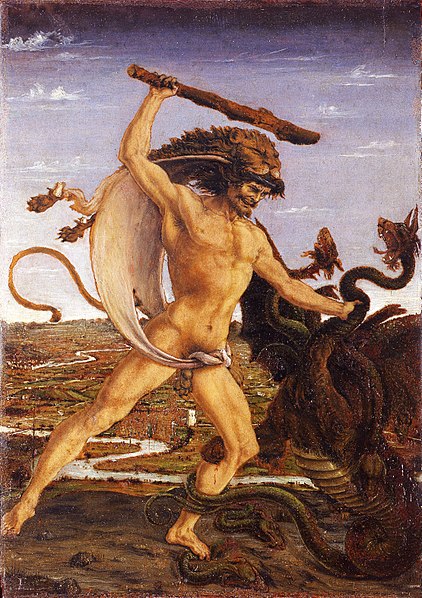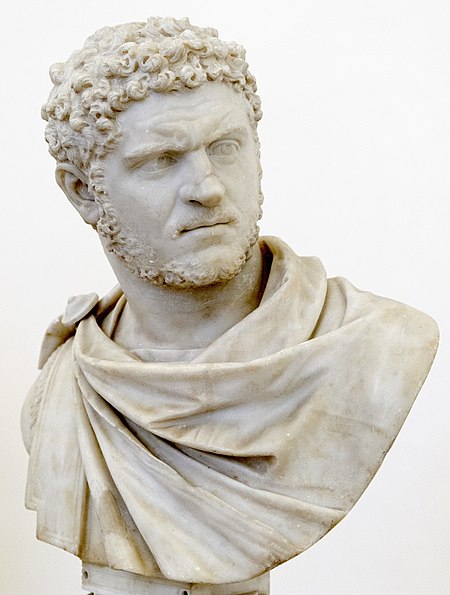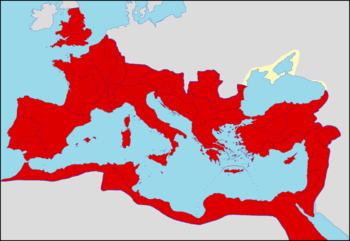|
Caracalla
–
Roman Emperor
: 198-217 A.D. –
Silver Denarius 18mm (2.84 grams) Struck circa 198-217 A.D.
Reference: RIC 206b, C 221
ANTONINVSPIVSFELAVG – Laureate head right.
PMTRPXVICOSIIIIPP – Hercules standing left, holding branch and club with
lion skin.
You are bidding on the exact item pictured,
provided with a Certificate of Authenticity and Lifetime Guarantee of
Authenticity.
Hercules is the Roman name for the Greek
divine
hero
Heracles
, who was the son of
Zeus
(Roman equivalent
Jupiter
) and the mortal
Alcmene
. In
classical mythology
, Hercules is famous for
his strength and for his numerous far-ranging adventures.

The Romans adapted the Greek hero’s iconography and myths for their
literature and art under the name Hercules. In later
Western art
and literature and in
popular culture
, Hercules is more
commonly used than Heracles as the name of the hero. Hercules was a
multifaceted figure with contradictory characteristics, which enabled later
artists and writers to pick and choose how to represent him. This article
provides an introduction to representations of Hercules in the
later tradition
.
Labours
Hercules is known for his many adventures, which took him to the far
reaches of the
Greco-Roman world
. One cycle of these
adventures became
canonical
as the “Twelve Labours,” but the
list has variations. One traditional order of the labours is found in the
Bibliotheca
as follows:
- Slay the
Nemean Lion
.
- Slay the nine-headed
Lernaean Hydra
.
- Capture the
Golden Hind of Artemis
.
- Capture the
Erymanthian Boar
.
- Clean the
Augean
stables in a single day.
- Slay the
Stymphalian Birds
.
- Capture the
Cretan Bull
.
- Steal the
Mares of Diomedes
.
- Obtain the girdle of
Hippolyta
, Queen of the
Amazons
.
- Obtain the cattle of the monster
Geryon
.
- Steal the apples of the
Hesperides
.
- Capture and bring back
Cerberus
.
The Latin
name Hercules was borrowed
through
Etruscan
, where it is represented variously
as Heracle
, Hercle, and other forms. Hercules
was a favorite subject for
Etruscan art
, and appears often on
bronze mirrors
. The Etruscan form
Herceler derives from the Greek Heracles via
syncope
. A mild oath invoking Hercules (Hercule!
or Mehercle!) was a common
interjection
in
Classical Latin
.

Baby Hercules strangling a
snake
sent to
kill him in his
cradle
(Roman marble, 2nd century CE)
Hercules had a number of
myths
that were distinctly Roman. One of
these is Hercules’ defeat of
Cacus
, who was terrorizing the countryside
of Rome. The hero was associated with the
Aventine Hill
through his son
Aventinus
.
Mark Antony
considered him a personal
patron god, as did the emperor
Commodus
. Hercules received various forms
of
religious veneration
, including as a
deity concerned with children and childbirth
,
in part because of myths about his precocious infancy, and in part because
he fathered countless children. Roman brides wore a special belt tied with
the “knot
of Hercules“, which was supposed to be hard to untie.[4]
The comic playwright
Plautus
presents the myth of Hercules’
conception as a sex comedy in his play
Amphitryon
;
Seneca
wrote the tragedy Hercules Furens
about his bout with madness. During the
Roman Imperial era
, Hercules was worshipped
locally from
Hispania
through
Gaul
.
Medieval mythography
After the Roman Empire became
Christianized
, mythological narratives were
often reinterpreted as
allegory
, influenced by the philosophy of
late antiquity
. In the 4th century,
Servius
had described Hercules’ return from
the underworld as representing his ability to overcome earthly desires and
vices, or the earth itself as a consumer of bodies. In medieval mythography,
Hercules was one of the heroes seen as a strong role model who demonstrated
both valor and wisdom, with the monsters he battles as moral obstacles. One
glossator
noted that when
Hercules became a constellation
, he showed
that strength was necessary to gain entrance to Heaven.
Medieval mythography was written almost entirely in Latin, and original
Greek texts were little used as sources for Hercules’ myths.
Renaissance
mythography
The
Renaissance
and the invention of the
printing press
brought a renewed interest
in and publication of Greek literature. Renaissance mythography drew more
extensively on the Greek tradition of Heracles, typically under the
Romanized name Hercules, or the alternate name
Alcides
. In a chapter of his book
Mythologiae (1567), the influential mythographer
Natale Conti
collected and summarized an
extensive range of myths concerning the birth, adventures, and death of the
hero under his Roman name Hercules. Conti begins his lengthy chapter on
Hercules with an overview description that continues the moralizing impulse
of the Middle Ages:
Hercules, who subdued and destroyed monsters, bandits, and criminals,
was justly famous and renowned for his great courage. His great and
glorious reputation was worldwide, and so firmly entrenched that he’ll
always be remembered. In fact the ancients honored him with his own
temples, altars, ceremonies, and priests. But it was his wisdom and
great soul that earned those honors; noble blood, physical strength, and
political power just aren’t good enough.
Caracalla (Latin:
Marcus Aurelius Severus Antoninus Augustus;4
April 188 – 8 April 217) was
Roman emperor
from 198 to 217 The eldest
son of
Septimius Severus
, for a short time he
ruled jointly with his younger brother
Geta
until he had him murdered in 211.
Caracalla is remembered as one of the most notorious and unpleasant of
emperors because of the massacres and persecutions he authorized and
instigated throughout the Empire.
Caracalla’s reign was also notable for the
Constitutio Antoniniana
(also called
the Edict of Caracalla), granting
Roman citizenship
to all freemen throughout
the Roman Empire
, which according to historian
Cassius Dio
, was done for the purposes of
raising tax revenue. He is also one of the emperors who commissioned a large
public bath-house (thermae)
in Rome. The remains of the
Baths of Caracalla
are still one of the
major tourist attractions of the Italian capital.

The
Severan Tondo
Early life

|
O:
laureate
draped bust of young
Caracalla
ANTONINVS
_AVGVSTVS
|
R:
Felicitas
holding
caduceus
and
cornucopia
FELICI_TAS
AVGG
|
|
silver
denarius
struck in
Rome
200; ref.: RIC 35 |
Caracalla, of mixed
Punic
–Roman
and Syrian
descent, was born Lucius Septimius
Bassianus in
Lugdunum
,
Gaul
(now
Lyon
,
France
), the son of the later Emperor
Septimius Severus and
Julia Domna
. At the age of seven, his name
was changed to Marcus Aurelius Septimius Bassianus Antoninus to create a
connection to the family of the philosopher emperor
Marcus Aurelius
. He was later given the
Caracallanickname
,
which referred to the Gallic hooded tunic he habitually wore and which he
made fashionable.
Reign (211)
Murder of
brother (211)
His father died in 211 at
Eboracum
(now
York
) while on campaign in northern
Britain. Caracalla was present and was then proclaimed emperor by the troops
along with his brother
Publius Septimius Antoninus Geta
. Caracalla
suspended the
campaign in Caledonia
and soon ended all
military activity, as both brothers wanted to be sole ruler thus making
relations between them increasingly hostile. When they tried to rule the
Empire jointly they actually considered dividing it in halves, but were
persuaded not to do so by their mother.
Then in December 211 at a reconciliation meeting arranged by their mother
Julia, Caracalla had Geta assassinated by members of the Praetorian Guard
loyal to himself, Geta dying in his mother’s arms. Caracalla then persecuted
and executed most of Geta’s supporters and ordered a
damnatio memoriae
pronounced by the
Senate against his brother’s memory.
Geta’s image was simply removed from all coinage, paintings and statues,
leaving a blank space next to Caracalla’s. Among those executed were his
former cousin-wife
Fulvia Plautilla
, his unnamed daughter with
Plautilla along with her brother and other members of the family of his
former father-in-law
Gaius Fulvius Plautianus
. Plautianus had
already been executed for alleged treachery against emperor Severus in 205.
About the time of his accession he ordered the
Roman currency
devalued, the silver purity
of the denarius
was decreased from 56.5% to 51.5%,
the actual silver weight dropping from 1.81 grams to 1.66 grams – though the
overall weight slightly increased. In 215 he introduced the
antoninianus
, a “double denarius”
weighing 5.1 grams and containing 2.6 grams of silver – a purity of 52%.
In the Roman
provinces
In 213, Caracalla went north to the German frontier to deal with the
Alamanni
tribesmen who were raiding in the
Agri Decumates
. The Romans did defeat the
Alamanni in battle near the river
Main
, but failed to win a decisive victory
over them. After a peace agreement was brokered and a large bribe payment
given to the invaders, the Senate conferred upon him the empty title of
Germanicus Maximus. He also acquired the surname Alemannicus at
this time. The following year the tyrant traveled to the East, to Syria and
Egypt never to return to Rome.
Gibbon
in his work describes Caracalla as
“the common enemy of mankind”. He left the capital in 213, about a year
after the murder of Geta, and spent the rest of his reign in the provinces,
particularly those of the East. He kept the Senate and other wealthy
families in check by forcing them to construct, at their own expense,
palaces, theaters, and places of entertainment throughout the periphery. New
and heavy taxes were levied against the bulk of the population, with
additional fees and confiscations targeted at the wealthiest families.
When the inhabitants of
Alexandria
heard Caracalla’s claims that he
had killed Geta in self-defense, they produced a satire mocking this as well
as Caracalla’s other pretensions. In 215, Caracalla savagely responded to
this insult by slaughtering the deputation of leading citizens who had
unsuspectingly assembled before the city to greet his arrival, and then
unleashed his troops for several days of looting and plunder in Alexandria.
According to historian Cassius Dio, over 20,000 people were killed.[citation
needed]
Domestic Roman
policy
Affiliation
with the army
During his reign as emperor, Caracalla raised the annual pay of an
average legionary to 675
denarii
and lavished many benefits on
the army which he both feared and admired, as instructed by his father
Septimius Severus who had told him on his deathbed to always mind the
soldiers and ignore everyone else. Caracalla did manage to win the trust of
the military with generous pay rises and popular gestures, like marching on
foot among the ordinary soldiers, eating the same food, and even grinding
his own flour with them.
With the soldiers, “He forgot even the proper dignity of his rank,
encouraging their insolent familiarity,” according to Gibbon. “The vigour of
the army, instead of being confirmed by the severe discipline of the camps,
melted away in the luxury of the cities.”

|
O:
laureate
head of Caracalla
ANTONINVS
PIVS
AVG
GERM
|
R:
Sol
holding
globe
, rising hand
P M
TR P
_XVIIII
COS
IIII
P P
|
|
silver
denarius
struck in
Rome
216; ref.: RIC 281b, C 359 |
His official portraiture marks a break with the detached images of the
philosopher–emperors who preceded him: his close-cropped haircut is that of
a soldier, his pugnacious scowl a realistic and threatening presence. This
rugged soldier–emperor iconic archetype was adopted by most of the following
emperors who depended on the support of the troops to rule, like his
eventual successor
Maximinus Thrax
.
Seeking to secure his own legacy, Caracalla also commissioned one of
Rome’s last major architectural achievements, the
Baths of Caracalla
, the 2nd largest public
baths ever built in ancient Rome. The main room of the baths was larger than
St. Peter’s Basilica
, and could easily
accommodate over 2,000 Roman citizens at one time. The bath house opened in
216, complete with libraries, private rooms and outdoor tracks. Internally
it was lavishly decorated with gold-trimmed marble floors, columns, mosaics
and colossal statuary.
Edict of
Caracalla (212)
The
Constitutio Antoniniana
(Latin:
“Constitution [or Edict] of Antoninus”) (also called Edict of Caracalla)
was an edict issued in 212 by Caracalla which declared that all free men in
the Roman Empire were to be given full Roman citizenship and all free women
in the Empire were given the same rights as Roman women.
Before 212, for the most part only inhabitants of Italia held full Roman
citizenship. Colonies of Romans established in other provinces, Romans (or
their descendants) living in provinces, the inhabitants of various cities
throughout the Empire, and small numbers of local nobles (such as kings of
client countries) held full citizenship also. Provincials, on the other
hand, were usually non-citizens, although many held the
Latin Right
.
The Roman Historian
Cassius Dio
contended that the sole
motivation for the edict was a desire to increase state revenue.At the time
aliens did not have to pay most taxes that were required of citizens, so
although nominally Caracalla was elevating their legal status, he was more
importantly expanding the Roman tax base. The effect of this was to remove
the distinction that citizenship had held since the foundation of Rome and
as such the act had a profound effect upon the fabric of Roman society.[16]
War with Parthia
According to the historian Herodian, in 216, Caracalla tricked the
Parthians into believing that he accepted a marriage and peace proposal, but
then had the bride and guests slaughtered after the wedding celebrations.
The thereafter ongoing conflict and skirmishes became known as the
Parthian war of Caracalla
.
Assassination
(217)

The Roman Empire during the reign of Caracalla.
While travelling from
Edessa
to continue the war with
Parthia
, he was assassinated while
urinating at a roadside near
Carrhae
on 8 April 217 (4 days after his
29th birthday), by Julius Martialis, an officer of his personal bodyguard.
Herodian
says that Martialis’ brother had
been executed a few days earlier by Caracalla on an unproven charge; Cassius
Dio, on the other hand, says that Martialis was resentful at not being
promoted to the rank of centurion. The escort of the emperor gave him
privacy to relieve himself, and Martialis then ran forward and killed
Caracalla with a single sword stroke. While attempting to flee, the bold
assassin was then quickly dispatched by a Scythian archer of the Imperial
Guard.
Caracalla was succeeded by his
Praetorian Guard Prefect
,
Macrinus
, who (according to Herodian) was
most probably responsible for having the emperor assassinated.
His nickname
According to
Aurelius Victor
in his Epitome de
Caesaribus, the
agnomen
“Caracalla” refers to a Gallic
cloak
that Caracalla adopted as a personal
fashion, which spread to his army and his court. Cassius Dio and the
Historia Augusta
agree that his
nickname was derived from his cloak, but do not mention its country of
origin.
Legendary king
of Britain
Geoffrey of Monmouth
‘s legendary
History of the Kings of Britain
makes
Caracalla a king of Britain, referring to him by his actual name “Bassianus”,
rather than the nickname Caracalla. In the story, after Severus’s death the
Romans wanted to make Geta king of Britain, but the Britons preferred
Bassianus because he had a British mother. The two brothers fought a battle
in which Geta was killed and Bassianus succeeded to the throne. He ruled
until he was betrayed by his
Pictish
allies and overthrown by
Carausius
, who, according to Geoffrey, was
a Briton, rather than the historically much later
Menapian
Gaul that he actually was.
|















